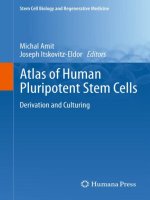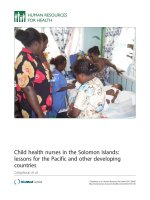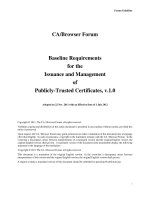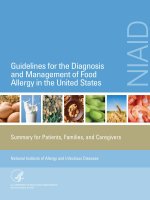Screen of nuclear receptors for the enhanced and alternative generation of induced pluripotent stem cells
Bạn đang xem bản rút gọn của tài liệu. Xem và tải ngay bản đầy đủ của tài liệu tại đây (3.45 MB, 138 trang )
SCREEN OF NUCLEAR RECEPTORS FOR THE
ENHANCED AND ALTERNATIVE GENERATION OF
INDUCED PLURIPOTENT STEM CELLS
DOMINIC HENG JIAN CHIEN
NATIONAL UNIVERSITY OF SINGAPORE
2012
SCREEN OF NUCLEAR RECEPTORS FOR THE
ENHANCED AND ALTERNATIVE GENERATION OF
INDUCED PLURIPOTENT STEM CELLS
DOMINIC HENG JIAN CHIEN
(B.Sc. (Hons), NTU)
A THESIS SUBMITTED FOR THE DEGREE OF
DOCTOR OF PHILOSOPHY
NUS GRADUATE SCHOOL FOR INTEGRATIVE
SCIENCES AND ENGINEERING
NATIONAL UNIVERSITY OF SINGAPORE
2012
i
Acknowledgements
First and foremost, I would like to thank my supervisor, Dr Ng Huck Hui for allowing
me to work in his laboratory back in 2008. I am also grateful for his invaluable
guidance, insights and direction throughout my PhD stint. Graduating from his
laboratory has not only made me a more critical, analytical, resourceful, intelligent
and independent researcher but also a more, determined and team-playing individual.
I would also like to thank Professor Davor Solter and Dr Thomas Lufkin, wonderful
members of my thesis advisory committee. They have been incredible with their
advice, support and time.
I thank Jiang Jianming for help with the ChIP, and ChIP-sequencing experiments,
Feng Bo for her help with the imaging of the teratoma tissue, Yuriy Orlov for ChIP-
seq analysis, Petra Kraus and Han Jianyong for relevant mouse work, Lim Seong Soo
for karyotyping, and Ng Jia Hui for help with the microarray analysis.
I also thank Kyle M. Loh for his wonderful intelligent discourse over scientific papers
and concepts as well as his unfailing help to vet through all my manuscripts and
papers.
A very big thank you goes out to Felicia Hong for her faithful love, unwavering
support and countless encouragement that she has showered upon me throughout all
these years. She will always be in my heart forever.
Last but not least, I thank God for his bountiful grace for granting me the strength and
wisdom to undertake this challenging PhD stint.
ii
Table of Contents
Acknowledgements……………………………………………………………………i
Table of Contents…………………………………………………………………….ii
Summary……………………………………………………………… ………….viii
List of Tables………………………………………………………………………….x
List of Figures………………………………………………………… …………xi
List of Symbols…………………………………………………………….……… xv
1. Introduction……………………………………………………………………… 1
1.1 A plethora of cell types governed by transcriptional and epigenetic regulation… 1
1.2 Embryonic stem cell, the common precursor cell……………………… ……….3
1.3 Important transcription factors governing the ESC fate: Oct4, Sox2 and Nanog 4
1.4 The first derivations of mouse and human ESCs………………………… …… 6
1.5 The issues that plague the utilisation of human ESCs for regenerative medicine 7
1.6 Differentiation was previously conceived as an irreversible process……… …….8
1.7 Methodologies to reprogram somatic cells to a state of pluripotency……… … 10
1.7.1 Cell fusion………………………………………………………… 10
1.7.2 Somatic cell nuclear transfer………………………………………… 11
1.7.3 Cell explantation…………………………………………….………….12
iii
1.7.4 Reprogramming with transcription factors…………………… ………13
1.8. The canonical reprogramming factors………………………………….……… 14
1.8.1 Oct4 in reprogramming………………………………….…………… 14
1.8.2 Sox2 in reprogramming………………………………………… …….14
1.8.3 Klf4 in reprogramming………………………………… ……….…….15
1.8.4 c-Myc in reprogramming……………………………………………….16
1.9 Advantages of iPSCs………………………………………………… …………17
1.10 The biology of reprogramming to iPSCs………………………………….……18
1.11 The rapid development of the field of iPSC………………………… ……… 21
1.12. Various cell types from various species reprogrammed……………………….23
1.13. Various techniques to generate iPSCs………………………………………….24
1.14. Screen for reprogramming factors……………………………………… ……26
1.14.1 Initial screen for factors that could reprogram………………….…….26
1.14.2 Screen for factors that could reprogram human fibroblasts………… 29
1.14.3 Screen for factors that could enhance the generation of human
iPSCs………………………………………………………………… …….31
1.14.4 Screen for factors that could replace exogenous Klf4 in
reprogramming…………………………………………………… ……… 33
1.14.5 Screen of human transcription factor library………………… …….35
iv
1.14.6 Other players in reprogramming: non-coding RNAs…………………36
1.14.6.1 MicroRNAs in reprogramming…………………………… 36
1.14.6.2 LincRNAs in reprogramming…………………….…………38
1.15 Nuclear receptors……………………………………………………………… 39
2. Materials and Methods………………………………………………… ………42
2.1 Cell Culture…………………………………………………………… ……… 42
2.1 Transfection………………………………………………………………………42
2.3 Mouse genetics………………………………………………… ………………42
2.4 Packing of retroviruses and infection…………………………………………….43
2.5 PCR genotyping of retroviral integration into the genome………… ………… 48
2.6 Bisulphite genomic DNA sequencing…………………………………….….… 48
2.7 Embryoid body formation and in vitro differentiation……………… ………….49
2.8 Teratoma formation assay………………………………………………….…….49
2.9 TUNEL apoptosis assay………………………………………………………….50
2.10 Western blot analysis…………………………………………………… …….50
2.11 Southern blot analysis……………………………………………………… …51
2.12 Immunofluorescence and alkaline phosphatase staining……………………… 51
2.13 RNA extraction, reverse transcription and quantitative real-time PCR… ……52
2.14 G-banded karyotyping……………………………………………… …………55
v
2.15 Microarray experiment and analysis……………………………………………55
2.16 ChIP assay………………………………………………………… ………….56
2.17 ChIP sequencing and analysis………………………………………………… 56
2.18 Gene targeting of POU5F1 locus by homologous recombination………… …57
3. Results ……………………………………………………………… …….…… 59
3.1 Setting up of the reprogramming assay………………………………….……… 59
3.2 Screen of nuclear receptors in reprogramming reveals Nr5a2 and Nr1i2 as
enhancers…………………………………………………………………………… 59
3.3 Nr5a2 enhances both the efficiency and kinetics of reprogramming 63
3.4 Nr5a2 can replace exogenous Oct4 in reprogramming………………………… 66
3.5 Nr5a2-reprogrammed cells fulfil pluripotent assays……………………… ……71
3.6 Epigenetic and transcriptional profiles of Nr5a2-reprogrammed cells are akin to
ESCs………………………………………………………………………………….74
3.7 The other nuclear receptors are unable to replace exogenous Oct4 in
reprogramming………………………………………………………… ………… 78
3.8 Nr5a1, the close family member of Nr5a2 possess similar reprogramming
capabilities as its counterpart…………………………………………….………… 78
3.9 Other transcription factors that bind to Oct4 regulatory region are unable to
replace exogenous Oct4 in reprogramming………………………………………… 82
3.10 Nr5a2 sumoylation mutants can further enhance the efficiency of
reprogramming…………………………………………………………….…………83
vi
3.11 Genome wide binding analysis of Nr5a2 in mouse ESCs reveals that it shares
many common target genes as its reprogramming counterparts, Sox2 and Klf4….…86
3.12 Nr5a2 works in part through Nanog in reprogramming…………………… …88
3.13 Nr5a2 works in a p53-pathway inhibition-independent fashion…………….….91
3.14 Nr5a2 does not enhance or replace exogenous Oct4 in human
reprogramming…………………………………………………………………… 93
4. Discussion……………………………………………………………… ……… 98
4.1 The identification of more nuclear receptor factors associated with
reprogramming…………………………………………………………….…………98
4.2. Nr5a2, the first factor reported that can replace exogenous Oct4 in
reprogramming…………………………………………………………………….…99
4.3 The parallel importance of Nr5a2 in mouse ESCs, early embryogenesis and
reprogramming……………………………………………………….…………… 101
4.4 Nr5a2 works in part through Nanog to mediate reprogramming……… …… 102
4.5 Nr5a2 additionally reprograms mouse EpiSCs besides mouse somatic
cells…………………………………………………………………………….……104
4.6 Species-specific actions of Nr5a2 in reprogramming……………….………….105
4.7 Mouse ESC-like human ESCs with Nr5a2…………………… ……………….106
4.8 Possible role of Nr5a2 in transdifferentiation………………………………… 108
vii
5. Conclusion…………………………………………………………….…………109
6. References……………………………………………………………………….110
viii
Summary
Differentiated cells are typified by their lineage restriction. Nevertheless, a pluripotent
state of unrestricted multilineage differentiation potential may be experimentally
endowed upon differentiated cells via the process of pluripotential reprogramming in
which the lineage restriction of differentiated cells is undone. The resultant cells,
known colloquially as induced pluripotent stem cells (iPSCs), become akin to
pluripotent embryonic stem cells (ESCs) and pluripotent cells of the early embryo,
thus gaining their characteristic developmental potential and other characteristics
diagnostic of pluripotent cells. Conferral of pluripotency upon differentiated cells is
achieved by overexpressing pluripotency-associated transcription factors in these
cells, such as Oct4, Sox2, Klf4, and c-Myc. Here, I have investigated whether a
heretofore underappreciated class of transcription factors, known as nuclear receptors,
can function similarly to conventional pluripotency transcription factors to reprogram
mouse fibroblasts into iPSCs. I have identified two nuclear receptors, Nrli2 and
Nr5a2, that can enhance the efficiency of iPSC generation by about 3- to 4-fold,
respectively. Saliently, Nr5a2 can fully replace the need for exogenous Oct4 to
generate mouse iPSCs, making it the first known factor capable of “replacing” Oct4 in
iPSC reprogramming. Its close family member Nr5a1 functions similarly in
substituting for Oct4. Piqued by how Nr5a2 can replace the singularly important Oct4
in iPSC generation, I have furthermore found that Nr5a2 is endogenously required for
iPSC generation—bereft of it, few iPSCs form. Moreover, in reprogramming
fibroblasts, Nr5a2 directly binds the Nanog enhancer and upregulates expression of
the dominant pluripotency factor Nanog. In brief, my study illuminates an unexpected
role for nuclear receptors in iPSC generation, identifies Nr5a2 as the first factor that
ix
can functionally substitute for Oct4 in iPSC reprogramming (formerly thought
indispensible), and sheds light on the mechanism of action of Nr5a2.
x
List of Tables
Table 1. List of 24 transcription factors screened by Takahashi and Yamanaka for
reprogramming……………………………………………………………………….27
Table 2. List of 14 factors screened by Yu et al for the reprogramming of human
fibroblasts……………………………………………………………………… … 29
Table 3. List of 16 factors screened by Zhao et al for their potential in augmenting the
efficiency of human reprogramming………………….………………………….… 31
Table 4. List of 19 factors screened by Feng et al for their potential in replacing
exogenous Klf4 in reprogramming…………………………………………… …….34
Table 5. List of 18 transcription factors discovered by Maekawa et al that can replace
Klf4 in reprogramming………………………………………………………….……35
Table 6. List of nuclear receptors screened for enhancers of reprogramming… … 62
Table 7. Pluripotent assays of Nr5a2-reprogrammed cells……………………… …74
xi
List of Figures
Figure 1. The developmental potential of a cell as depicted by an epigenetic
landscape………………………………………………………………………………9
Figure 2. Different methodologies to reprogram……………………… ……………10
Figure 3. Reprogramming of somatic cells with transcription factors…………… 14
Figure 4. Stages of reprogramming to mouse iPSCs………………………… …….20
Figure 5. Mechanism of action of nuclear receptors…………………………………40
Figure 6. The Pou5f1-EGFP reporter harboured by the MEFs that were used in the
reprogramming assay……………………………………………….……………… 59
Figure 7. Schematic diagram showing the reprogramming protocol employed for the
generation of mouse iPSCs……………………………………….………………… 60
Figure 8. Transduction of Pou5f1-EGFP MEFs with OSKM retroviruses…… … 61
Figure 9. Gene expression of nuclear receptors that were cloned into the pMX
retroviral vector………………………………………………………………… … 63
Figure 10. Screen of nuclear receptors in search for enhancers of reprogramming.…64
Figure 11. Time-course reprogramming assay with enhancers of reprogramming …65
Figure 12. Tunel assay of Nr1i2 and Nr5a2-infected MEFs…………………………66
Figure 13. Reprogramming assay to investigate the ability of the reprogramming
enhancers in substituting Oct4, Sox2 and Klf4……………………………… …….67
xii
Figure 14. Characterization of N
2
SKM iPSCs………………………….……………68
Figure 15. Reprogramming assay to investigate the ability of Oct4-replacer, Nr5a2 in
its ability to reprogram in the absence of c-Myc………………………….………….69
Figure 16. Characterization of N
2
SK iPSCs……………………………….…………70
Figure 17. Genotyping and karyotyping of Nr5a2-reprogrammed cells………….….71
Figure 18. EB differentiation assay and teratoma formation assay of Nr5a2-
reprogrammed cells………………………………………………………………… 72
Figure 19. Nr5a2-reprogrammed cells exhibit germline incorporation, germline
contribution and give rise to chimeras………………………………………….……73
Figure 20. Promoter methylation profile of Nr5a2-reprogrammed cells…………….76
Figure 21. Transcriptome analysis of Nr5a2-reprogrammed cells…………… …….77
Figure 22. Reprogramming assay to test for the ability of the other nuclear receptors
in substituting of Oct4…………………………………………………………… …78
Figure 23. Reprogramming assay to test enhancement and canonical factors-
replacement capabilities of Nr5a1……………………………………………………79
Figure 24. Characterization of Nr5a1 iPSCs…………………………………………80
Figure 25. Genotyping and karyotyping of Nr5a1-reprogrammed cells…… ………80
Figure 26. EB differentiation assay and teratoma formation assay of Nr5a1-
reprogrammed cells………………………………………………………………… 81
xiii
Figure 27. Promoter methylation profile of Nr5a1-reprogrammed cells…….………82
Figure 28. Investigation if other transcription factors that bind to Oct4 regulatory
regions could also substitute for Oct4 in reprogramming……………… ………… 83
Figure 29. Schematic diagram of 2KR and 5KR sumoylation mutants of Nr5a2… 84
Figure 30. Investigation of sumoylation mutants of Nr5a2 in their ability to enhance
reprogramming……………………………………………………………… …… 85
Figure 31. Genome wide mapping of Nr5a2 binding sites…………… ……………87
Figure 32. ChIP assay to investigate the binding of Nr5a2 to the Nanog enhancer
during the reprogramming of MEFs………………………………………….………88
Figure 33. Upregulation of Nanog during reprogrammig with Nr5a2… ………… 89
Figure 34. Gene and protein expression of Nr5a2 after shRNA-mediated
knockdown…………………………………………………………………… …….89
Figure 35. Knockdown of Nr5a2 during reprogramming………………… ……….90
Figure 36. Reprogramming assay with combined transduction of Nr5a2 and Nanog in
the presence of OSKM……………………………………………………… …… 91
Figure 37. Heatmap depicting p53 and p21 expression after Nr5a2 knockdown… 92
Figure 38. Reprogramming of p53 WT, Het and KO MEFs in the presence of
Nr5a2…………………………………………………………………………………93
Figure 39. Creation of POU5F1-EGFP human ESC line…………………… …….96
xiv
Figure 40. Reprogramming of POU5F1-EGFP human fibroblasts……… ……… 97
Figure 41. Assay to test if NR5A2 can enhance or replace OCT4 in human
reprogramming…………………………………………………………….…………97
xv
List of Symbols
2i 2 inhibitors (Gsk3 and Mek chemical inhibitors)
AP Alkaline phosphatase
BAC Bacterial artificial chromosome
bp Base pair
cDNA Complementary deoxyribonucleic acid
ChIP Chromatin immunoprecipitation
ChIP-seq Chromatin immunoprecipitation sequencing
CpG Cytosine phosphate guanine
DBD DNA binding domain
DNA Deoxyribonucleic acid
dpi Days post infection
EpiSC Epiblast stem cell
ESC Embryonic stem cell
EGFP Enhanced green fluorescent protein
FACS Fluorescence activated cell sorting
GCNF Growth cell nuclear factor
GFP Green fluorescence protein
H3K4me3 Histone 3 lysine 4 trimethylation
xvi
H3K9me3 Histone 3 lysine 9 trimethylation
H3K27me3 Histone 3 lysine 27 trimethylation
HRE Hormone response element
ICM Inner cell mass
iPSC Induced pluripotent stem cell
kb Kilo basepairs
LBD Ligand binding domain
LIF Leukemia inhibitory factor
LincRNA Long intergenic non-coding ribonucleic acid
Lrh-1 Liver receptor homolog-1
MEF Mouse embryonic fibroblast
miRNA / miR Micro ribonucleic acid
MOI Multiplicity of infection
mRNA Messenger ribonucleic acid
N
1
SKM Nr5a1, Sox2, Klf4 and c-Myc
N
2
SKM Nr5a2, Sox2, Klf4 and c-Myc
N
2
SK Nr5a2, Sox2 and Klf4
OSK Oct4, Sox2 and Klf4
OSKM Oct4, Sox2, Klf4 and c-Myc
xvii
PBST Phosphate buffered saline with Tween 20
PCR Polymerase chain reaction
RA Retinoic acid
RAR Retinoic acid receptor
RNA Ribonucleic acid
SCNT Somatic cell nuclear transfer
siRNA Short interfering ribonucleic acid
SSEA1 Stage-specific embryonic antigen 1
Tgf-β Transforming growth factor-β
Utf1 Undifferentiated embryonic cell transcription factor 1
WT Wild type
1
1. Introduction
1.1 A plethora of cell types governed by transcriptional and epigenetic regulation
The intricately complex mammalian body is composed of myriad cell types, each
highly specialised to perform distinct cellular functions in specific tissues or organs.
This wide spectrum of cell types in the body encompasses specialised cells such as the
metabolic enzyme-laden hepatocytes in the liver, the impulse-firing neurons in the
brain, and the mitochondria-enriched muscle cells within our musculature. In addition,
distinct cell types assume unique morphologies designed to perform specialised
functions. For instance, neurons possess lipid-based encapsulations, known as myelin
sheaths that enshroud axons that permit the rapid propagation of impulses, whereas
epithelial cells are cuboidal or columnar in shape so as to allow its tight packing in
body cavity linings.
These expansive distinctions between various cell types can in part be attributed to the
unique compendium of messenger ribonucleic acids (mRNAs) which each cell
possesses. Fundamentally, mRNAs are expressed transcripts from genes embedded in
genomic deoxyribonucleic acid (DNA), which in turn encode the basic units of
hereditary information within a cell. This unique cocktail of mRNAs, also known as
the transcriptome of a cell, is expressed in a process known as transcription, and
transcription is largely modulated by highly specialised proteins known as
transcription factors and epigenetic modulators. Transcription factors are DNA-
binding proteins that can recognise and bind to specific DNA consensus sequences
and modulate gene expression. They commonly bind to the regulatory elements of
genes such as their promoters, enhancers and even silencers in order to activate or
repress the expression of these genes which they dock at. Upon binding of
2
transcription factors, the enzyme, RNA polymerase II may be recruited to promoter
regions to transact gene transcription
1
. In addition, a host of other co-factors such
activators and repressors may also be recruited to assist in the modulation of gene
regulation. This transcriptional control is highly conserved from the simplest of model
organism such as yeast to the highly complex of mammals such as us humans.
Strikingly, the more complex the transcriptional regulation within a cell, the more
complex is the organism
2
. Incidentally, transcription factors belong to the largest
protein family in humans
3
.
Transcriptional control per se is only one tier of cell fate regulation within a cell and
other complex regulation is involved as well. For instance, epigenetics, which
essentially refers to the mechanistic regulation (not in the context of transcription
factors) of cellular phenotype regardless of the basic sequence information harboured
by the genomic DNA, provides another mode of regulation within a cell.
Interestingly, epigenetic factors may even be recruited by transcription factors to
modulate cell fate. Delving more into the mechanisms behind transcriptional
differences will reveal further that various epigenetic marks are in part responsible in
bringing about these distinctions in genetic expression.
One of the common epigenetic marks is DNA methylation, a process whereby a
methyl group is incorporated onto a nucleotide, typically a cytosine that is usually
found in cytosine-phosphate-guanine (CpG)-rich islands. A gene with a highly
methylated promoter and enhancer would typically render it transcriptionally inactive,
whereas unmethylated regulatory elements would commonly indicate that the genes
are expressed. Specialised enzymes known as DNA methyltransferases are
responsible for incorporating methylation marks on DNA. On the other hand,
demethylases are responsible for removing these methylation marks. In addition to
3
DNA methylation, other epigenetic modulators such as histone modifications marks
also play a role in regulating gene expression. For example, histone 3 lysine 4
trimethylation (H3K4me3) marks are known to be found on active genes while
histone 3 lysine 27 trimethylation (H3K27me3) and histone 3 lysine 9 trimethylation
(H3K9me3) marks are typically found on the promoters of repressed genes
4,5
.
Besides, DNA methylation and histone modifications per se, epigenetic changes can
also be mediated by chromatin remodelling complexes such as that of Polycomb
Repressive Complexes (PRCs), which primarily comprise Polycomb Group (PcG)
proteins and are important in the context of development
6
. While the repressive
complex of PRC2 is known to promote H3K27me3 marks to silence genes
7
, PRC1
binds to repressive marks to induce conformational changes in chromatin
8,9
. The
switch/sucrose non-fermentable (SWI/SNF) complex is another chromatin
remodelling complex and notable constituents of this complex are the trithorax group
(TrxG) proteins, which are H3K4 methytransferases
10
.
All in all, both transcriptional and epigenetic regulation work in concert to modulate
cell fate and hence bring about various differentiated cells within our body with each
cell harbouring the same genetic material but are remarkably still able to assume
distinct cellular functions and different morphologies.
1.2 Embryonic stem cell, the common precursor cell
Intriguingly, regardless of the dissimilarities of the myriad somatic cell types present
in our body, these cells essentially originate from a common precursor cell within the
early developing embryo. These versatile cells, known as embryonic stem cells
(ESCs), are derived from the epiblast of the early peri-implantation mouse embryo
11
4
and are characterised by their ability to divide indefinitely in culture as well as give
rise to all cell types in the body. This intrinsic and unique ability to differentiate into
various cell types originating from the three major germ layers, the primitive
endoderm, the primitive ectoderm and the mesoderm, is known as pluripotency. This
pluripotent hallmark of ESCs makes these cells ideal models to study development as
we can investigate the myriad paths of cellular differentiation that ESCs embark on.
In addition, as ESCs can be coerced into specific cell types under specialised cell
culture conditions in vitro, they indeed hold great promise for regenerative medicine.
As such, specific differentiated tissues derived from ESCs can be transplanted into
patients to replace diseased tissues or perhaps organs.
1.3 Important transcription factors governing the ESC fate: Oct4, Sox2 and
Nanog
As mouse ESCs are naïve cells that have yet to assume any developmental fate and
are continuously self-replicating, they make excellent models to study transcriptional
regulation of the pluripotent and self-renewing network as well as their directed
differentiation. At the heart of the transcriptional network of ESCs is a trio of
transcription factors, comprising Oct4, Sox2 and Nanog that serve as the important
architects of ESC pluripotency and self-renewal.
Oct4, a POU (Pit/Oct/Unc) homeodomain protein that is expressed from the Pou5f1
gene, is highly expressed in the inner cell mass (ICM) of the mouse embryos as well
as in ESCs. Besides its expression in ESCs, Oct4 is also highly expressed in epiblast
stem cells (EpiSCs) and primordial germ cells (PGCs)
12
. The importance of this
transcription factor is evidenced by the fact that the ablation of Oct4 results in
5
embryonic lethality at the peri-implantation stage of murine development
13
.
Furthermore, the cells that do develop in the ICM are devoid of pluripotentiality and
tend to differentiate towards a trophoblast fate
13
. Similarly, when the expression of
Oct4 is reduced in ESCs, differentiation tends towards the trophectodermal lineage
14
.
Strikingly, it is essential that the expression of Oct4 be kept at a fine-tuned and
regulated fashion in undifferentiated ESCs as even a 1.5-fold increment of Oct4
expression can result in their differentiation towards the primitive endodermal and
mesodermal fate
14
.
Sox2, which belongs to the Sox (SRY-related HMG box) family of proteins,
possesses a DNA-binding domain known as the HMG (high mobility group) box.
Sox2 is not only highly expressed in ESCs but also in other cell types such as neural
progenitor cells
15
. Similar to the Pou5f1-null murine embryos, the knockout of Sox2
results in peri-implantation lethality, albeit at a slightly later stage of development as
compared to the Pou5f1-null ones
16
. Again, akin to Oct4 deficiency in ESCs, the
repression of Sox2 expression inclines ESCs to differentiate towards the
trophectodermal lineage
17
. On the other hand, the overexpression of Sox2 may result
in the neural differentiation of ESCs
18
. Sox2 is also known to form a heterodimer with
Oct4 and they synergistically regulate many important downstream target genes such
as Nanog, undifferentiated embryonic cell transcription factor 1 (Utf1) and fibroblast
growth factor 4 (Fgf4)
19-22
.
Nanog, another homeodomain transcription factor that is highly expressed in ESCs, is
also an important modulator in the maintenance of the ESC fate. Similar to Oct4,
Nanog is highly expressed in PGCs
23
. Nanog was initially discovered from a screen of
novel factors that can sustain mouse ESCs under leukemia inhibitory factor (LIF)-
deficient conditions
24
. The ability of Nanog in dispensing the requirement of LIF-
6
Stat3 was also discovered by another independent group through a screen of factors
identified from in silico differential display
25
. Nanog-null embryos fail to form a
proper epiblast and cells within the ICM tend to differentiate into parietal
endodermal-like cells
25
. In addition, cells devoid of Nanog tend towards
extraembryonic endodermal differentiation, a phenotype akin to Pou5f1 knockdown
25
.
However, unlike Oct4 and Sox2, Nanog dimerises with itself and this homodimer
interacts with other ESC-relevant factors to sustain ESC pluripotency
26
. In addition,
unlike Oct4 and Sox2, subpopulations of ESCs do not express Nanog. However, ESC
subpopulations devoid of Nanog tend to differentiate towards the primitive
endodermal lineage
27
. Nonetheless, Nanog is an important transcription factor in
ESCs that has been implicated in the moulding and coercing of cells towards a
pluripotent ESC state
28
.
Definitely, the transcription factors, Oct4, Sox2 and Nanog are not the only important
pluripotent mediators in ESCs. There are also other transcription factors such as Sall4,
Tbx3, Ronin and Zic3 that uphold the pluripotent framework within ESCs
29-32
.
1.4 The first derivations of mouse and human ESCs
ESCs were first isolated by Martin Evans, Matthew Kaufman and Gail Martin from
mouse embryo back in 1981
33,34
. It was only very much later in 1994 that human
ESCs were harvested from human blastocysts by Ariff Bongso and co-workers
35
.
However, they were unable to maintain the harvested human ESCs for long term in
culture and were hence unable to derive a stable cell line. Unlike Bongso et al, Jamie
Thomson and co-workers went on to successfully derive and patent five independent
human ESC lines in 1998
36
. These successful derivations of multiple human ESC









